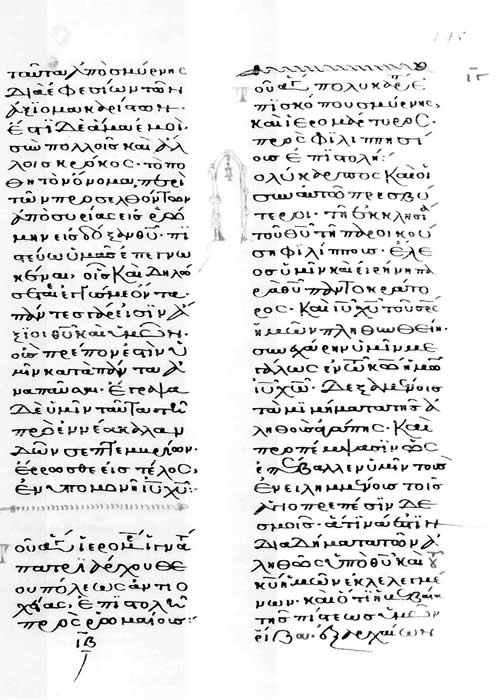
The
Seamless Joining of Polycarp (1.1-9.2) with Barnabas (5.7b-21.9)
Robert A. Kraft (22se2008)
Some things to note and ponder:
[The following paragraph is adapted from Kraft, Commentary on Barnabas and the Didache (1965), concerning the textual situation in Barnabas]
(3) G is a convenient designation for the family of
nine Greek manuscripts in which Barnabas 5.7 ff. is welded on
to Polycarp, Philippians 9.2 without any indication, thus
forming a hybrid document which is half Polycarp, half Barnabas. The
oldest of these manuscripts dates from the eleventh century, and they
are all obviously derived from a common mutilated ancestor which is at
least that old. That the type of text preserved in G
is often even older may be seen by its frequent support from the
corrections in S2. Sometimes G
and L(atin, from only one codex) show a tendency to
agree against H [Greek, Bryennios codex] and S*
[Greek Sinaiticus, first hand].
Polycarp, Philippians 9.1-3 [adapted from TLG]
(1.) Παρακαλῶ
οὖν πάντας ὑμᾶς
πειθαρχεῖν τῷ λόγῳ
τῆς δικαιοσύνης καὶ ὑπομένειν [/ἀσκεῖν o\mg/ b f p n t
Eus (c?)] πᾶσαν
ὑπομονήν, ἣν καὶ εἴδατε [ἴδατε v o* |εἴδετε
o\mg/ b f p n t (c?)] κατ’ ὀφθαλμοὺς οὐ μόνον ἐν τοῖς μακαρίοις Ἰγνατίῳ
καὶ Ζωσίμῳ
καὶ Ῥούφῳ, ἀλλὰ καὶ ἐν ἄλλοις τοῖς ἐξ ὑμῶν καὶ ἐν αὐτῷ Παύλῳ καὶ
τοῖς λοιποῖς [/ἄλλοις v o] ἀποστόλοις· (2.)
πεπεισμένους, ὅτι οὗτοι πάντες οὐκ εἰς κενὸν ἔδραμον, ἀλλ’ ἐν πίστει καὶ δικαιοσύνῃ, καὶ ὅτι εἰς
τὸν ὀφειλόμενον αὐτοῖς τόπον εἰσὶ παρὰ τῷ κυρίῳ, ᾧ καὶ συνέπαθον. οὐ
γὰρ τὸν
νῦν ἠγάπησαν αἰῶνα, ἀλλὰ τὸν
ὑπὲρ ἡμῶν ἀποθανόντα καὶ δι’ ἡμᾶς ὑπὸ τοῦ
θεοῦ ἀναστάντα.
[from Funk's edition (see below)] (1) Rogo igitur [ergo o] omnes vos, insistere verbo iustitiae [/eius v] et patientiae, quam [< p] et oculata [/oculta v*] fide vidistis, non solum in his [< f o v] beatissimis [+ illis f o v], Ignatio scilicet [< o] et Zosimo et Rufo, sed et in aliis, qui ex vobis sunt, et in ipso [< f o] Paulo et [+ in f o] ceteris apostolis; (2) confidentes, quia [+~ non f o] hi omnes non [< f o] in vacuo [/vacuum f (vg) | vano p] cucurrerunt, sed in fide et iustitia; et ad debitum sibe locum a [/ cum f o | < v] Domino, cui et compassi sunt, abierunt, quia non [+ in v] hoc praesens [< f o v] saeculum [/saeculo v] dilexerunt, sed eum [/cum v], qui [< v] pro ipsis et pro nobis mortuus est et a Deo resuscitatus.
[Lightfoot-Harmer-Holmes ET] (1) I urge all of you, therefore, to obey the teaching about righteousness and to exercise unlimited endurance, like that which you saw with your own eyes not only in the blessed Ignatius and Zosimus and Rufus but also in others from your congregation and in Paul himself and the rest of the apostles; (2) be asured that all these "did not run in vain" but in faith and righteousness, and that they are now in the place due them with the Lord, with whom they also suffered together. For they did not "love the present world," but him who died on our behalf and was raised by God for our sakes.
[Note: the next sections (chs. 10-12,
13b-14) are known only from the Latin translation (preserved in 13 or
14 MSS and not yet critically edited as of 1956; see F.X.Funk's edition
in Die Echtheit der Ignatianischen Briefe aufs neue vertheidigt,
mit einer literarischen Beilage: die alte lateinishche Ubersetzung der
Usher'schen Sammlung der Ignatiusbriefe und des Polykarp-Briefes
[Tubingen: H. Laupp, 1883], citing Latin MSS f, o, p, v], and the Greek
of 9.2b
and most of ch. 13 is known only from a citation in Eusebius, HE3.36.13-15]
Eusebius, HE 3.36.13-14 [adapted from TLG; repeated verbatim also in Nicephorus Callistus Xanthropulus, HE (apud TLG, 13-14th c)]
(13.) καὶ ὁ Πολύκαρπος δὲ τούτων
αὐτῶν μέμνηται ἐν τῇ φερομένῃ αὐτοῦ πρὸς
Φιλιππησίους ἐπιστολῇ, φάσκων αὐτοῖς ῥήμασιν·
Martyrdom of Ignatius (Roman, 2nd c?) 12
[TLG]
(2.) καὶ Πολύκαρπος δὲ ἐπίσκοπος ὢν τῆς ἐν Σμύρνῃ παροικίας τούτων
μέμνηται Φιλιππησίοις γράφων·
Παρακαλῶ οὖν πάντας ὑμᾶς, ἀδελφοί, πειθαρχεῖν καὶ ἀσκεῖν πᾶσαν
ὑπομονήν, ἣν εἴδετε κατ’ ὀφθαλμοὺς οὐ μόνον ἐν τοῖς μακαρίοις Ἰγνατίῳ
καὶ Ῥούφῳ καὶ Ζωσίμῳ, ἀλλὰ καὶ ἐν ἄλλοις πολλοῖς τοῖς ἐξ ὑμῶν καὶ
ἐν
αὐτῷ τῷ Παύλῳ καὶ τοῖς σὺν αὐτῷ πεπιστευκόσιν, ὅτι οὗτοι πάντες οὐκ εἰς
κενὸν ἔδραμον, ἀλλ’ ἐν πίστει καὶ δικαιοσύνῃ· καὶ ὅτι εἰς τὸν
ὀφειλόμενον αὐτοῖς τόπον εἰσὶν παρὰ κυρίῳ, ᾧ καὶ συνέπαθον. οὐ γὰρ τὸν
νῦν ἠγάπησαν αἰῶνα, ἀλλὰ τὸν ὑπὲρ ἡμῶν ἀποθανόντα Χριστὸν
καὶ ἀναστάντα
ἐπόθησαν.
(3.) καὶ μετὰ βραχέα·
Τὰς ἐπιστολὰς Ἰγνατίου τὰς πεμφθείσας ἡμῖν ὑπ’ αὐτοῦ καὶ ἄλλας
ὅσας
εἴχομεν παρ’ ἡμῖν ἐπέμψαμεν ὑμῖν, καθὼς ἐνετείλασθε, αἵτινες
ὑποτεταγμέναι εἰσὶν τῇ ἐπιστολῇ ταύτῃ, ἐξ ὧν μεγάλα
ὠφεληθήσεσθε·
περιέχουσι γὰρ πίστιν καὶ ὑπομονὴν τὴν εἰς τὸν κύριον ἡμῶν.
(6b.) αὐτὸς δέ, ἵνα καταργήσῃ τὸν θάνατον καὶ τὴν ἐκ νεκρῶν ἀνάστασιν δείξῃ, ὅτι ἐν σαρκὶ ἔδει αὐτὸν φανερωθῆναι, ὑπέμεινεν, (7.) ἵνα [+ καὶ S] τοῖς πατράσιν τὴν ἐπαγγελίαν ἀποδῷ καὶ αὐτὸς ἑαυτῷ τὸν λαὸν τὸν καινὸν [/κενὸν G(-p)] ἑτοιμάζων [/ὀνομάζων S*] ἐπιδείξῃ ἐπὶ τῆς γῆς ὤν, ὅτι τὴν ἀνάστασιν αὐτὸς ποιήσας κρινεῖ.
Barnabas 5.6b-7 Latin [from J. M. Heer ed. (1908)]
ille autem, ut vacuam faceret mortem et de mortuis resurrectionem ostenderet, quie in carne oportebat eum adparere, sustinuit (7) ut promissum parentibus redderet et ipse sibi populum parans resurrectione facta in terris iudicabit illos.
[Kraft ET of Barnabas] 6. The prophets, after they had received special insight from him, prophesied concerning him. And he submitted so that he might break the power of Death and demonstrate the resurrection from the dead -- thus it was necessary for him to be manifested in flesh. 7. Also (he submitted) so that he might fulfill the promise to the fathers and, while he was preparing the new people for himself and while he was still on earth, to prove that after he has brought about the resurrection he will judge.
Text and ranslation of the joined section:
οὐ γὰρ τὸν νῦν ἠγάπησαν αἰῶνα, ἀλλὰ τὸν ὑπὲρ ἡμῶν ἀποθανόντα καὶ δι’ ἡμᾶς ὑπὸ τὸν λαὸν τὸν καινὸν [/κενὸν G(-p)] ἑτοιμάζων [/ὀνομάζων S*] ἐπιδείξῃ ἐπὶ τῆς γῆς ὤν, ὅτι τὴν ἀνάστασιν αὐτὸς ποιήσας κρινεῖ.
For it was not that they loved the present world, but the one who died for us. And on our account by preparing the vain people he showed, while he was on the earth, that when he had accomplished the resurrection he will judge..
Manuscripts Containing the Hybrid
Document [with folios of the Barnabas
portion noted]:
G1 (v o)
G2 (f p)
G3 (n t c a s b)
Visual details:
Start of Polycarp in MS v (11-13th c):

The page preceding the join in MS v (folio 197b)

The join in MS v (folio 198, column one, line 5):
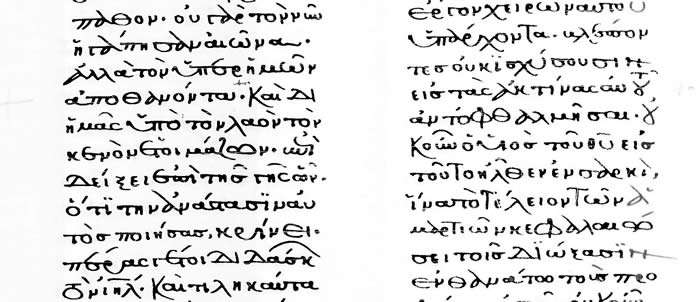
The ending in MS v:
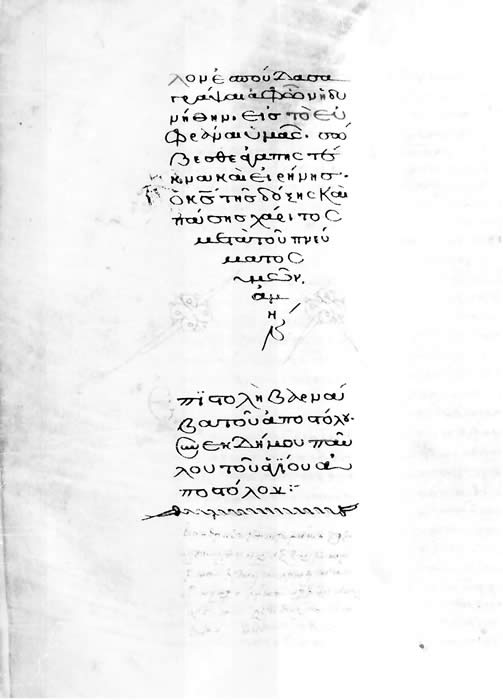
The join in MS o (16th c):

The marginal note in MS o:
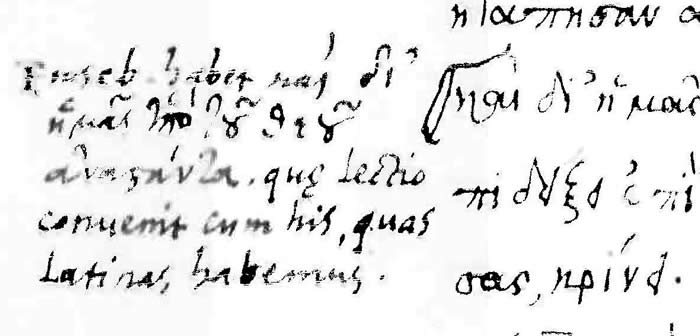
The ending in MS o:
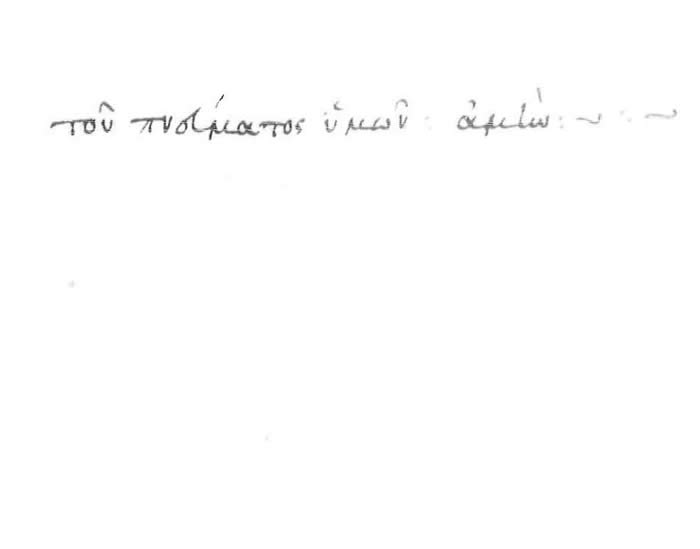
The initial note in MS b ("late" -- copy of v?):
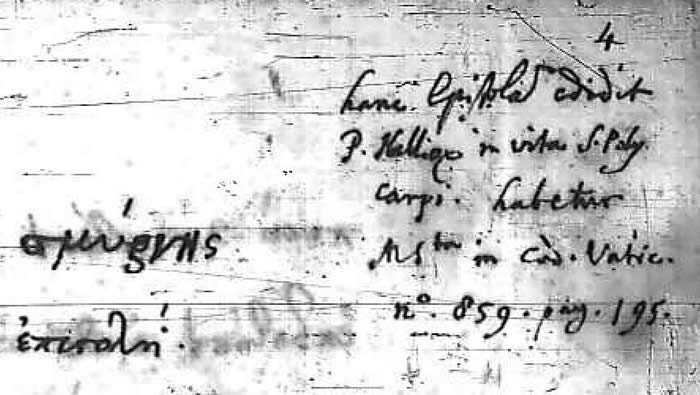
The ending in MS b:
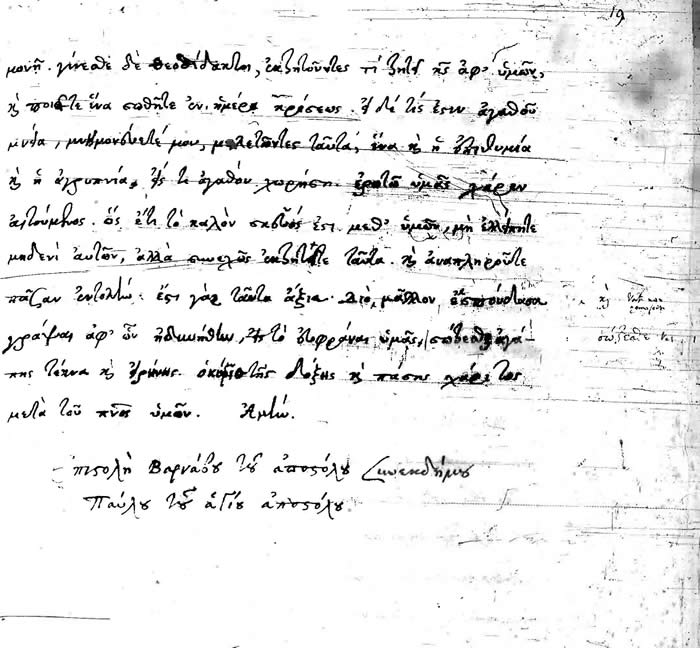
The join in MS f (15-16th c):

The join in MS p (16th c):

The join in MS n (15th c):

The join in MS t (15-16th c):

The join in MS c (15-16th c):
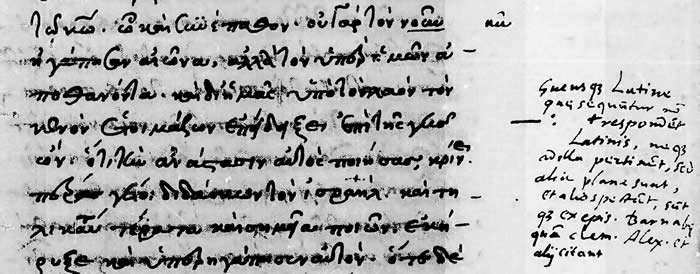
Just for fun -- the text that follows Poly-Barn in Ms v --
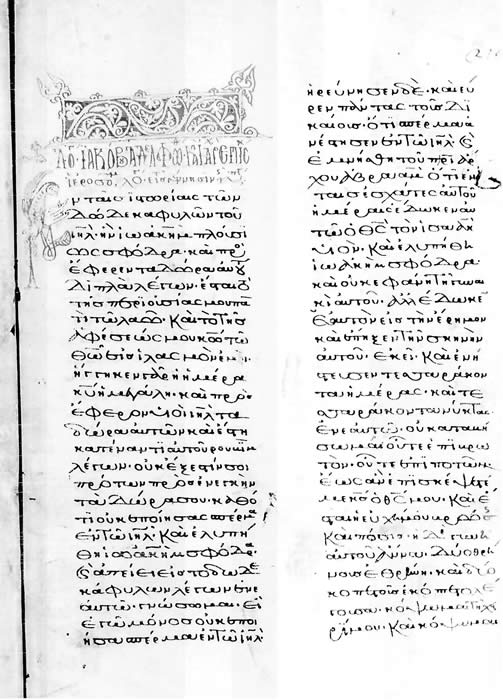
//end for now//